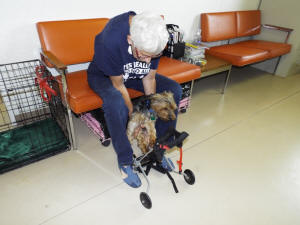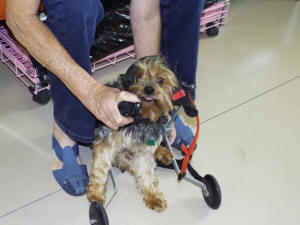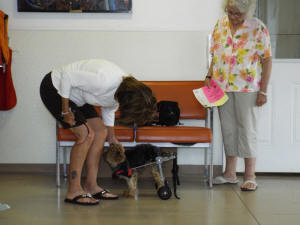|
 In the business world, a business only ten years old is still
experiencing growing pains, and owners are sometimes working hard to
keep the doors open and make the business profitable. But the HSLC
has come much farther than the typical business in its first years.
Through the generosity of many, they have a facility that is paid
for and they are debt free, but how did it happen? Recently that
question was posed to long-term volunteers Ellen Burbage, Wanda
Stevens, and Marilyn Wheat. In the business world, a business only ten years old is still
experiencing growing pains, and owners are sometimes working hard to
keep the doors open and make the business profitable. But the HSLC
has come much farther than the typical business in its first years.
Through the generosity of many, they have a facility that is paid
for and they are debt free, but how did it happen? Recently that
question was posed to long-term volunteers Ellen Burbage, Wanda
Stevens, and Marilyn Wheat.
How have you stayed successful?
Burbage summed it up saying it was the support of the community, in
volunteerism as well as financial support. Burbage said that in her
lifetime, she has lived a few places, but never in her lifetime has
she been in a community that was more giving, more generous, more
caring about others than in Logan County.
The volunteers are tremendous, and they work hard, again for the
love of animals, not for praise or any self-righteous reason, but
just to give their love to an animal that needs them.
When there have been fundraisers and calls for dollars, the
community has come forward opening billfolds and pocketbooks laying
out their dollars to help.
During the year, the HSLC hosts a breakfast in the spring that is
very well attended, they hold the Route 66 Garage sale that brings
in thousands of donated items that in turn sell for thousands of
dollars. The new calendar fundraiser this year is going well, and
the first print order of the calendars is selling down. People come
to Woofstock, and they do buy items from the vendors, and food and
drinks. The tree of hope fundraiser is coming up, and the cookies
sales held at Christmas time are very well supported.
A wish to grow
But, as is the case with any not-for-profit organization, there is
always a wish list of more that could be done if more dollars were
available. The three women talked about things that are needed.
They would like to be able to put up larger fenced in areas for dog
runs. Of course, they need more volunteers, and they would like to
offer more training for those volunteers, in animal behaviors for
example. In taking in an animal, particularly if it has been in a
less than perfect situation before arriving, there can be issues
with socialization. Stevens said that in addition to adopting the
pets out to good families, the goal is also to make the pets good
citizens in their community.
Talking about making animals good citizens, Stevens told a story of
a young dog who came to the shelter that was so hyper and so active,
he was hard to handle. Volunteers gave the time they could to being
with the animal and trying to settle him down a bit, but they were
not able to spend the amount of time needed. Stevens said they at
the shelter talked about the dog, a great dog, but one they were
afraid would be unadoptable.
However, after a time a family came that did get attached to the
hyper dog, and they decided they would adopt him. She said they gave
their time and love to the animal, and when she saw him again, she
did not even believe the difference that one-on-one, constant
relationship had made. Nearly grown, though still a pup, when he
came in all nervous and hyper, he became a calm, gentle, loving
companion for the family.
She said that is the ultimate goal, and the thing that takes time
and trained volunteers, is to adopt out an animal that will fit with
the family, fit in its living environment, be happy and healthy, and
be a good citizen.
While the above story ended well for the young dog, it could have
gone differently. With more volunteers and more training, the pet
behavior could have been better before it was adopted.
Shelter takes work and money
Burbage commented that it take a ton of work to do what the HSLC is
doing. She said that the work involved includes taking care of the
animals, but also taking care of the building, the grounds, and
doing the less than attractive duties like changing out litter boxes
and cleaning the indoor kennels.
To keep the doors open, it takes from $80,000 to $90,000 per year
for utilities, maintenance, food, vet bills.
 Wheat added saying that since opening, the shelter has facilitated
more than 3,000 surgeries, and that costs money.
Volunteers are also needed for fundraisers and other activities.
With only one paid employee, the balance of the work has to be done
by volunteers. Burbage commented about herself and the other two
women, “We do it for the love of the animals.” And that is the
mentality of the majority of those who do volunteer.
At the kennel being a volunteer, helping with the animals, is not a
matter of just walking in the door and starting to play with the
pets. There is an orientation and also a training process that the
volunteers go through before they actually begin working with the
animals.
Working with the animals is indeed more than just playing and
feeding. Stevens summed it up saying the intent is to make the
adopted pet a “good citizen” which is to say, not just a good pet,
but a good member of the community.
There is also a goal of putting the volunteer in the right position.
Stevens said, for example someone who is frail, or not very strong,
might not be the best fit to work with the larger dogs. That person
may need to be led into the task that is most suitable to their
ability. The need for volunteers
The HSLC has been blessed with volunteers over the years, but there
is always a need for more. On a daily basis it takes 11 people in
multiple shifts just to care for the animals.
Stevens said that for the dogs, the ideal situation would be to have
three volunteers caring for the dogs on the morning shift, two
volunteers taking the noon shift, and two taking the evening shift.
She said this could be seven individuals, but a lot of the time, it
ends up being one person taking multiple shifts.
[to top of second column] |

For the cats, two
volunteers are needed for the morning shift and two for the evening
shift. If an animal comes in with health issues, then the demand for
volunteers increases because that animal needs more personal care as
it recovers from its illness.




The downs of being a volunteer
For the three long-term volunteers, it is a very rewarding
experience to see an animal go to a new home and live out a long and
happy life, in a “forever home.” However, sometimes the path to get
the animal there can be challenging, and for a volunteer,
emotionally draining.
For the volunteers, Burbage said it isn’t all sunshine and roses.
For example, it can be heart breaking to deal with the folks who are
bringing their animals to the shelter. She reminded that these
animals are not strays found roaming the streets. They are pets that
someone loves, animals that have become a part of a family. There
are reasons the family has to let the animal go, maybe a relocation
where pets are not allowed, a health issue where the owner is no
longer able to care for the pet, or some other extenuating
circumstance. When they come to the shelter, these people are not
happy to be doing what they are doing. They need assurances that
they are doing what is right for the animal, and that the HSLC will
take good care of their pet, and find it a very good home.
And, it isn’t easy to go into a home on a humane investigation and
order the removal of an animal. Sometimes this is a child’s pet and
the child too is being abused or neglected. The animal and the child
may have a special bond, and there are separation issues for both.
Then, there are the times when a family comes and wants an animal,
but they are unable to adopt. There is a screening process involved
in adoption. This is done to assure that the animal is going to a
safe home where it will not be abused, or neglected, but it also
assures that the family is equipped to take on the responsibility of
an animal. The bottom line, a family may want to be pet owners, but
other circumstances may indicate that they are not a good fit for a
specific animal or not a good candidate for any kind of animal.
Telling someone that can be very difficult.
We appreciate all they do
Burbage began wrapping up talking about the volunteers, who have to
face these scenarios and the others who give their talents in other
areas. She commented, “I can’t say enough about how important our
volunteers are and how much we appreciate what they do every day for
HSLC."
For the many people around the county who love animals, and are pet
parents, looking deep into the work of the HSLC, they can surely see
that this is a worthwhile and important service offered in our
community. But the HSLC only works because it is supported so well
by the community and by its volunteers who ultimately become
ambassadors for the program.
For those who have supported the HSLC through these first ten years,
the organization wishes to send you a sincere and heartfelt
“thank-you.” For those who continue to work and contribute
financially, thank you.
For those who have not yet made a decision to help in some way, know
that no contribution is too small, whatever you can do, will be
appreciated by the HSLC, but more importantly by the animals who
live there, and wait patiently for a loving family to come and offer
them a “forever home.”
[Nila Smith]
 |